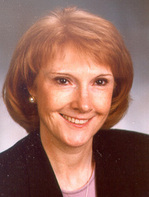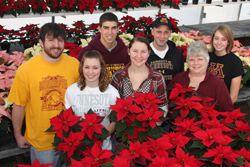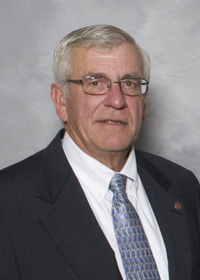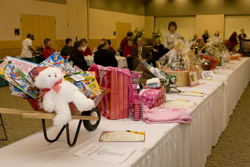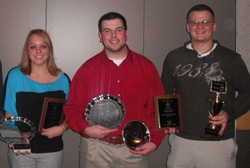 Once again, the Collegiate Crops Judging Team from the University of Minnesota, Crookston was in the top three finishers at the national crops judging contests held in November. At the contests held in Kansas City, Mo., on November 17, and Chicago, Ill., on November 21, the team from the U of M, Crookston finished third overall. Members of the team included: Sophomore Theresa Hamel from Lakota N.D.; Junior Jakob Heggedal from Badger, Minn.; and Junior Mark Riepe from Perham, Minn. The team was coached by Associate Professor Charles "Chuck" Habstritt.
Once again, the Collegiate Crops Judging Team from the University of Minnesota, Crookston was in the top three finishers at the national crops judging contests held in November. At the contests held in Kansas City, Mo., on November 17, and Chicago, Ill., on November 21, the team from the U of M, Crookston finished third overall. Members of the team included: Sophomore Theresa Hamel from Lakota N.D.; Junior Jakob Heggedal from Badger, Minn.; and Junior Mark Riepe from Perham, Minn. The team was coached by Associate Professor Charles "Chuck" Habstritt.In the photo at left (l to r): Hamel, Riepe, and Heggedal.
The crops contests integrate a student's knowledge of agronomy into three categories: seed analysis, grain grading and crop and weed identification.
In Kansas City, individual finishes included a second place finish in grain grading by Heggedal, while Riepe was in sixth and Hamel in eighth. Overall, Heggedal finished fifth, Riepe finished seventh, and Hamel finished eleventh. The addition to their third place overall finish, the team finished second overall in grain grading and fourth in both seed analysis and crop and weed identification.
Results from the contest in Chicago included a first place finish for Heggedal in grain grading and a sixth place finish in seed analysis. Heggedal's individual finish was fifth overall. Other finishes included a sixth place finish by Riepe and eighth place finish by Hamel in grain grading. Riepe finished sixth overall while Hamel was fourteenth. The team once again finished second overall in grain grading and fourth in seed analysis as well as crop and weed identification.
Out of a possible 1200 points in the grain grading portions of the Kansas City and Chicago crops contests, Heggedal missed just 8 points.
Preparation for the contests begins early in the semester and requires intense preparation. Crops teams from the Crookston campus have placed in the top three more than 25 times over their history. For more than 35 years, Habstritt has served as a coach to the highly successful Collegiate Crops Judging Team on the Crookston campus. He was also responsible for compiling the rules and regulations book that has been used for national contests in both Chicago and Kansas City.
The Chicago contest began in 1923 and has been held every year except in 1929 and during World War II (1942-'46). The Kansas City Contest was held the first time in 1929 and has been held annually through 1941, with the exception of 1942-'46.
Today the University of Minnesota, Crookston delivers more than 25 applied-science undergraduate degree programs and 50 concentrations, including several online degrees, in agriculture; arts, humanities and social sciences; business; math, science and technology; and natural resources. To learn more, visit www.UMCrookston.edu.
Contact: Rob Proulx, lecturer, 218-281-8136 (prou0041@umn.edu); Elizabeth Tollefson, assistant director, communications, 218-281-8432 (ltollefs@umn.edu)


